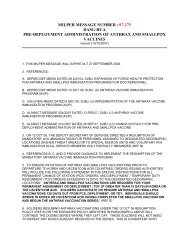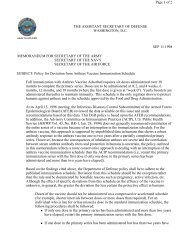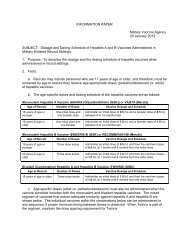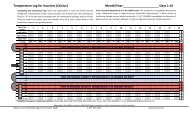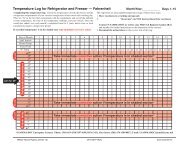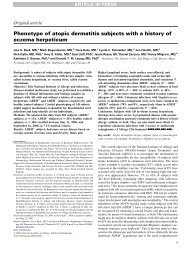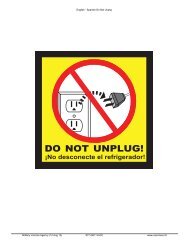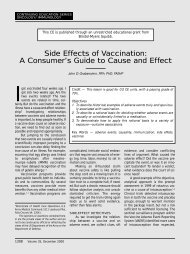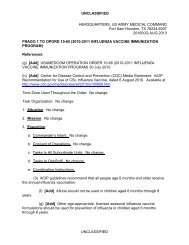Anthrax Vaccine - Health Care Providers Briefing - MILVAX
Anthrax Vaccine - Health Care Providers Briefing - MILVAX
Anthrax Vaccine - Health Care Providers Briefing - MILVAX
You also want an ePaper? Increase the reach of your titles
YUMPU automatically turns print PDFs into web optimized ePapers that Google loves.
IntroductionDepartment of Defense<strong>Health</strong>care Provider’s<strong>Briefing</strong>ANTHRAX VACCINE14 Sep 091
<strong>Briefing</strong> Outline• Key Messages• Policy• Threat• Disease• <strong>Vaccine</strong>• Dosage Schedule and Route of Administration• Exemptions• Expected Local Adverse Reactions• Storage and Handling• Immunization Documentation• Contacts2
Key Messages• Your health and safety is our top concern• Receiving the vaccination is the only around-the-clock protectionavailable for service members against this very real threat• The Food and Drug Administration says the anthrax vaccine protectsagainst all forms of anthrax disease and is safe• Vaccination protects you, your unit, and your mission3
Policy History of the AVIP• Dec 97: Secretary of Defense ordered the AVIP• Mar 98: Vaccinations began in Southwest Asia• Aug 98: Vaccinations began in Korea• 2000-01: Slowdowns due to shortage. After supply restored, programresumed in 2002• Oct 04: Injunction issued against DoD• Jan 05: FDA issues Emergency Use Authorization (EUA)• Dec 05: FDA formally issues Final Rule/Final Order• Oct 06: Deputy Secretary of Defense issued AVIP policy to re-establisha mandatory program for those in higher risk areas and with specialroles; policy allows voluntary vaccinations for other groups• Dec 06: Under Secretary of Defense for Personnel and Readinessreleased DoD implementation guidance for the AVIP policy• Dec 08: <strong>Vaccine</strong> route and dosing schedule change4
Current Policy ImplementationMandatory and Voluntary Vaccinations• Vaccinations are mandatory for DoD servicemembers, emergency essential designatedcivilians, and contractor personnel performingmission-essential services assigned to:• Central Command area of responsibility, theKorean Peninsula, and the Horn of Africa for 15 ormore consecutive days• Special units with biowarfare or bioterrorismrelated missions• Specialty units with approved exception to policy• Vaccinations shall begin, to the extent feasible,up to 120 days prior to deployment or arrival inhigher threat areas5
Current Policy Implementation• Vaccinations are voluntary for DoD servicemembers who are not in the mandatory groupsand have received at least one dose of <strong>Anthrax</strong><strong>Vaccine</strong> Adsorbed during or after 1998• Vaccinations are voluntary for DoD civilians andadult family members; contractors and theiraccompanying US citizen family members:• Residing in Central Command area ofresponsibility, the Korean Peninsula, and theHorn of Africa for 15 or more consecutive days• DoD Civilian Personnel Management Serviceconcluded notification to national unions on 12Jan 076
Current Policy Implementation• Ensure ALL potential vaccine recipients receivethe most current educational trifold brochureavailable, dated 15 Jan 2009 or later• Ensure an Individual’s <strong>Briefing</strong> is available at allimmunization sites• Educate potential vaccine recipients aboutanthrax threat and benefits, plus risks ofvaccination• Screen potential vaccine recipients to confirmeligibility and potential medically exemptpersonnel7
Threat• Inhalation anthrax is 99% lethal if unprotected,unvaccinated, or untreated• <strong>Anthrax</strong> spores are the most likely bioweapon• Relatively easy and cheap to produce• Extremely stable – can withstand harshenvironmental conditions and remain dormantup to 50 years• Can be aerosolized and delivered in a varietyof methods• Odorless, colorless, tasteless, difficult to detect8
<strong>Anthrax</strong> Infections• Recognized as an illness for centuries• Once common where livestock wereraised, now controlled using vaccine forlivestock• Human infection from direct contact withinfected animals, animal products, oranthrax spores• Still a problem in Asia and Africa• Terror attacks via US mail in Fall 20019
Microbiology of <strong>Anthrax</strong>Gram-positive spore-forming rod10
Pathogenesis• Spore enters through broken skin,gastrointestinal tract, or lung• Ingested by macrophages• Transported to regional lymph nodes• Germinates in regional nodes• Local production of toxins cause edema& necrosis of tissue• Septicemia & toxemia• Seeding of other organ systems11
<strong>Anthrax</strong> Toxins: Building Blocks & EffectsEdema FactorProtective AntigenLethal FactorMW 89,000MW 83,000MW 90,000Edema ToxinLethal ToxinIncreased Cyclic AMPLocal EdemaMacrophage Lysis12
Infections• Three types of anthrax infection• Cutaneous anthrax (skin)• Gastrointestinal anthrax (GI tract)• Inhalational anthrax (lungs)13
Cutaneous <strong>Anthrax</strong>• Cutaneous: Contact with spore-infected animal hides or productsthrough a break in the skin• Incubation period: 1-5 days• Symptoms: Papule forms in 1-2 days; changes to vesicle;ruptures to form ulcer and develops black eschar (scab); lasts 2-3weeks14
Gastrointestinal <strong>Anthrax</strong>• Gastrointestinal: Ingestingpoorly- or undercooked infectedmeat• Incubation period: 2-5 days• Symptoms: Fever, abdominalpain, nausea, vomiting of blood,and bloody diarrhea• Oropharyngeal anthrax ->compromised airway• Mortality up to 25-60%15
Inhalation <strong>Anthrax</strong>• Inhalation: Spores enter lungs; ingested bymacrophages, migrate to lymph nodes. Sporesgerminate, rapidly multiply and produce toxins• Incubation period: 1-6 days• Symptoms:• Initially flu-like: Mild fever, myalgias andmalaise, cough, chest discomfort, 2-4 days• Slight improvement, hours to days• Severe respiratory distress quicklyprogresses to shock and death in hours todays• Toxins cause destruction of pulmonary andthoracic tissues, result in multiple organ failure16
Diagnosis of Inhalation <strong>Anthrax</strong>fevermalaisefatigue• Initial symptoms nonspecific• Development of respiratory distress• Chest X-ray with widened mediastinum• Usually no infiltrates• Sputum not helpful; spores settle in tissue• Hemorrhagic pleural effusion or meningitis• Blood cultures: Positive late in course of illness17
Inhalation <strong>Anthrax</strong> Treatment• Early IV antibiotics and intensive care required• Mortality may still reach 45% to 80%• Current treatment of choice (2001—multi-antibiotictherapy):• Ciprofloxacin 400 mg IV q 8-12 h• Doxycycline 200 mg IV x 1, then 100 mg IV q 12 h• Disease not spread by respiratory secretions• Use ‘Standard Precautions’• Clinical Issues• Emerging Infectious Diseases, Bioterrorism-Related<strong>Anthrax</strong>, October 2002 theme issue18
Post-Exposure Prophylaxis• Inhalation or GI anthrax: IV ciprofloxacin ordoxycycline and additional 1-2 antibiotics withactivity against anthrax (60 days)• Cutaneous anthrax: Oral ciprofloxacin ordoxycycline; oral penicillin used historically (60days if suspect bioterrorism; 7-10 days naturalinfection)• Post-exposure prophylaxis• Oral ciprofloxacin or doxycycline (60 days)• Studies show antibiotics plus anthrax vaccinemost beneficial• Antibiotics are still indicated even when fullyimmunizedTreat as early assuspected; intensivesupportive care19
<strong>Anthrax</strong> <strong>Vaccine</strong> Facts• Licensed by the Federal government since 1970• Administered in US to at-risk veterinarians,laboratory workers, and livestock handlers• Over 9 million doses to more than 2.3 millionpeople since Mar 98• <strong>Vaccine</strong> primes immune system to fight anthrax• Manufactured in US by Emergent BioSolutions• “AVA,” BioThrax TM . Package insert with each vial.• Official name: <strong>Anthrax</strong> <strong>Vaccine</strong> AdsorbedThis vaccine contains no whole or live anthrax bacteria;therefore, it is impossible to contract the disease from it.20
Independent Scientific Reviews• FDA Advisory Panel on Bacterial <strong>Vaccine</strong>s and Toxoids(Federal Register, 1985)• Defense <strong>Health</strong> Board (DHB), advising DoD, 1994 to present• Cochrane Collaboration, Oxford (<strong>Vaccine</strong>, 1998; 2004)• Working Group on Civilian Biodefense (JAMA, 1999, 2002)• CDC’s Advisory Committee on ImmunizationPractices (ACIP) (MMWR, 2000)• <strong>Anthrax</strong> <strong>Vaccine</strong> Expert Committee (AVEC)(Pharmacoepidemiology & Drug Safety 2002, 2004)• National Academy of Sciences (IOM), 2002• FDA Review of VAERS reports supporting FDA's Final Ruleand Final Order (2005)• Adverse events after anthrax vaccination reported to VAERS,1990-2007, (<strong>Vaccine</strong>, 2009)21
<strong>Vaccine</strong> Efficacy in Humans• Brachman et al. Am J Public <strong>Health</strong> 1962;52:432-45• Efficacy: 92.5% (95% CI: 65-100%), jointly againstcutaneous and inhalation anthrax (table 8)• Inhalation anthrax:• 5 cases / 448 unvaccinated people• 0 cases / 149 vaccinated people• Manufacturing improvements, 1960s CDC study• Microaerophilic, more PA, less EF and LF• Safety and efficacy reaffirmed by FDA advisory panel,Federal Register 1985; 50:51002-117• Repeated in Final Order issued by FDA, 19 Dec 0522
<strong>Vaccine</strong> Efficacy in Non-Human PrimatesInhalation <strong>Anthrax</strong>• 55 monkeys vaccinated twice• Challenged with spore aerosol, dozens tothousands of times the median lethal dose, 8,16, 38, or 100 wks later• 52 survived. All unvaccinated control monkeysdied• 10 monkeys vaccinated once• Challenged with virulent spores 6 weeks later• All survived. All unvaccinated control monkeysdied• Overall, 62 of 65 survived, 95% vaccineprotective efficacy against inhaled anthraxspore challenge• Correlates of immunity to infer from animal tohumans have not been fully developed95% survival rate23
How <strong>Anthrax</strong> <strong>Vaccine</strong> Prevents DiseaseFILTER<strong>Anthrax</strong> vaccine is filtered,so that it does not contain whole bacteria.Therefore, anthrax vaccineCannot give you the disease.+ =+Lethal Toxin=Edema Toxin24
Immunization Schedule• 5 doses over 18 months; annual booster• Do not compress schedule• Adjust schedule for individual delays• Do not “restart” series if it has been interruptedDose 1 2 3 4 5030 days4 weeks150 days 180 days 180 days6 months12 months18 months25
Injection TechniqueIntramuscularTissueDeltoidAreaInjection over deltoid rather than triceps is preferred, in case of swelling26
Exemptions from VaccinationTEMPORARYPERMANENT• Some people should not get anthrax vaccine• Temporary medical exemptions include• Women who are pregnant, or uncertain if pregnant• Short-term immune suppression• Acute diseases, surgery• Medical evaluation or condition pending• Permanent exemptions can include• Severe allergic reaction or other serious reactionafter a previous dose of anthrax vaccine• People with a history of severe latex sensitivity• HIV infection or other chronic immune deficiencies• People who had Guillain-Barré Syndrome (GBS)• Recovery from previous anthrax infection<strong>Anthrax</strong> vaccine is licensed for individuals from 18 to 65 years of age27
PregnancyAccording to the CDC's Advisory Committee on Immunization Practices(ACIP):“there is no convincing evidence of risk from vaccinating pregnant women withinactivated virus or bacterial vaccines or toxoids.”• Vaccinations routinely deferred during pregnancy• Before vaccination, ask each woman if she is pregnantor if there is the possibility of trying to become pregnant• No reason to delay conception after vaccination• <strong>Anthrax</strong>-vaccinated & -unvaccinated women at FortStewart (JAMA, 2002): same rates of conception, delivery• <strong>Anthrax</strong>-vaccinated & -unvaccinated men at fertility clinic:same sperm concentration, rate of pregnancy• Vaccination during pregnancy• Do not vaccinate pregnant women unless potentialbenefits of vaccination outweigh potential risk to fetus28
Injection Site ReactionsMany may experience temporary pain and swelling after the shotMild side effects such as redness and tenderness at the site of vaccination are common• For both genders, IM administration significantlyreduces adverse events at injection sites• Monitoring of all adverse events• Burning• Soreness• Redness• Itching• Swelling• Local pain at the injection siteYou can call the DoD <strong>Vaccine</strong> Clinical Call Center at 866.210.646929
Managing Adverse Events After Any VaccinationMinimizing injection-site reactions and systemic events• Screen for previous adverse reactions• Do not give next dose if side effectspersist from previous vaccination• Issue temporary exemption ifsymptoms persist• Treat (and pre-treat) adverse events• Consult healthcare provider skilled indiagnosis and management of vaccineadverse events for permanentexemption30
Adverse Event ReportingWhen in doubt, report it!• <strong>Vaccine</strong> Adverse Event ReportingSystem (VAERS)• FDA and CDC review 100% ofadverse-event reports• All VAERS forms reviewed byindependent panel of expert civilianphysicians for 4 years• DoD requires healthcare workerssubmit a VAERS Form for• Loss of duty 24 hours or longer(> 1 duty day)• Hospitalization• Suspected vaccine vialcontamination• Other submissions are encouraged• Anyone can submit a VAERS Form1-800-822-7967www.vaers.hhs.gov31
Reserve Component Adverse Event Guidance• If someone experiences an adverse event in anon-duty status that is possibly associated witha vaccination• Should seek medical evaluation at a DoD,USCG, or civilian medical treatment facility, ifnecessary• Should Report the event to your unit Commanderor designated representative as soon as possible• Should see local medical department orsquadron for guidance• Commander will determine Line of Duty and/orNotice of Eligibility status, if required• Submit VAERS for any suspected adverseevent888-647-6676www.tricare.mil/tma/MMSO32
Storage and Handling• Keep anthrax vaccine refrigerated• Store between 2° to 8° C (36° to 46° F)• Temperature check twice a day, evenwith alarm system• Keep logs for up to three years• DO NOT FREEZE• Once vial opened, use until expiration date• Do not pre-filling vaccine into syringes• Storage devices• Medical Grade/Household refrigerator• VaxiCool or VaxiPacwww.usamma.army.mil/vaccines/anthrax/antxhome.cfm33
Record Keeping• Automated immunization tracking (primary)• Service systems and DEERS central repository• Do not give any vaccination more than 4 days early• Written entries• Required documentation• Deployable Medical Record; Adult Preventive &Chronic <strong>Care</strong> Flowsheet (DD Form 2766, DD Form2766C)Date immunizedName of vaccineManufacturerLot numberSeries numberDosageVaccinator’s nameVIS date34
Conclusion• <strong>Anthrax</strong> spores are a lethal threat to our forces• FDA has repeatedly said the anthrax vaccine is safe and effective• The life-saving benefits of anthrax vaccine make this an essentialimmunization program• For service members to understand the value of anthrax vaccination,they need your help• Make sure service members understand the anthrax vaccine dosingschedule – remind them when their next vaccination in the series isdue• Expeditiously assist anyone experiencing an adverse event in gettingproper medical care and advice35
Resources• <strong>MILVAX</strong> Agency• www.vaccines.mil• www.anthrax.mil• www.vaccines.mil/anthrax• vaccines@amedd.army.mil• 877.GET.VACC• DoD <strong>Vaccine</strong> Clinical Call Center• 866.210.6469• <strong>Vaccine</strong> <strong>Health</strong>care Centers for help with adverse eventmanagement• www.vhcinfo.org• 202.782.0411• Information for Civilian <strong>Health</strong>care <strong>Providers</strong>Call the Military Treatment Facility (MTF) where the member isenrolled OR contact the Military Medical Support Office (MMSO)• www.tricare.mil/tma/MMSO• 888.647.6676 if the member is not enrolled to an MTF• USAMMA DOC• www.usamma.army.mil• 301.619.431836
Closing37
www.vaccines.milwww.vaccines.mil38



